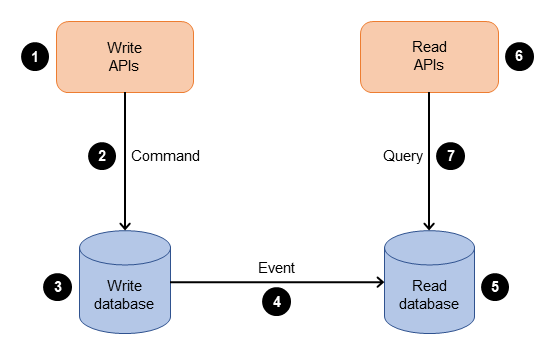Understanding the “good,” the “bad,” and the “ugly” of CQRS can help in determining when and how to implement it effectively.

CQRS AKA Command-Query-Responsibility-Segregation, jargons aside is a very simple Read/Write pattern at its core. This pattern offers several compelling advantages but also comes with its own set of challenges.
Generalises CQS to services, at the architectures level: it applies the CQS principle by using separate Query and Command interfaces and usually data models to retrieve and modify data, respectively.
CQRS excels in scenarios with high read load, complex domain logic. However, alternatives like CRUD, micro-services, and event-driven architectures can be better choices when simplicity, service independence, or real-time processing are prioritised.
When choosing an architectural pattern, it’s crucial to evaluate the complexity, scalability needs, and operational overhead to find the most suitable approach for your specific use case “there’s no glove that fits all” so to speak.

The Good: Benefits of CQRS
- Performance Optimization:
- Read/Write Optimization: Since the read and write operations are separated, each can be optimized independently. Queries can be optimized for quick data retrieval, while commands can be optimized for data integrity and business rules enforcement.
- Scalability: With separate models, it’s possible to scale read and write operations differently. Read-heavy applications can benefit significantly by scaling the read side independently.
- Simpler Business Logic:
- Reduced Complexity in Commands: By focusing on commands, the system can ensure that the business logic is only applied during state changes, simplifying the command model.
- Tailored Query Models: Query models can be designed specifically for the needs of the user interface or reporting without the constraints of the command model’s structure.
- Enhanced Flexibility:
- Different Data Stores: Allows using different storage technologies for reads and writes, which can be beneficial for performance or cost reasons.
- Adaptable to Change: The system can adapt to changing requirements more easily since the read and write sides can evolve independently.
- Improved System Maintenance:
- Isolated Concerns: Separating commands and queries can simplify debugging and maintenance because each side deals with different types of operations.
- Easier Refactoring: Changes to the read model do not necessarily impact the command model and vice versa, making it easier to implement new features or adjust existing ones.
- Event Sourcing Integration:
- Historical Data and Replayability: When combined with event sourcing, CQRS allows capturing every change to the system state as an event, which can be replayed to reconstruct past states or audit actions.
The Bad: Challenges of CQRS
- Increased Complexity:
- Learning Curve: Understanding and implementing CQRS requires a solid grasp of both the concept and its practical implications, which can be complex.
- Development Overhead: Building and maintaining separate read and write models can increase the development effort and require more sophisticated architecture and infrastructure.
- Consistency Issues:
- Eventual Consistency: In a distributed system, especially when combined with event sourcing, ensuring immediate consistency across the read and write sides is difficult. The read side may lag behind the write side, leading to eventual consistency challenges.
- Synchronization: Keeping the read and write models synchronized and up-to-date can be challenging, particularly in real-time applications.
- Infrastructure and Deployment:
- More Components to Manage: CQRS often involves multiple components such as separate databases, event buses, and messaging systems, increasing the complexity of the deployment and monitoring process.
- Operational Complexity: Maintaining and operating a CQRS-based system might require more sophisticated tools and processes.
- Cost:
- Resource Intensive: Running separate data stores and maintaining potentially more complex infrastructure can lead to higher operational costs.
- Development and Maintenance Costs: The additional code and infrastructure needed to manage the separate read and write paths can increase the time and cost of development and ongoing maintenance.
The Ugly: Potential Pitfalls of CQRS
- Misapplication:
- Not Always Necessary: Using CQRS in simple systems or where the benefits don’t outweigh the costs can lead to unnecessary complexity without significant gains. It is crucial to evaluate whether the pattern is genuinely needed.
- Overengineering: There is a risk of overengineering, where the solution becomes too complex for the problem at hand, leading to wasted resources and effort.
- Eventual Consistency Side Effects:
- User Experience Issues: The lag in data synchronization between the command and query models might result in outdated data being presented to users, potentially causing confusion or errors.
- Data Synchronization Bugs: Complex synchronization logic between the read and write models can introduce subtle bugs that are difficult to diagnose and fix.
- Complex Testing and Debugging:
- Testing Difficulties: Testing a CQRS system can be more challenging due to the separate paths for commands and queries, each requiring distinct testing strategies.
- Debugging Challenges: Diagnosing issues can be more complex as bugs might be introduced in the coordination between command and query models or in the eventual consistency mechanisms.
Summary
CQRS can be a powerful pattern for managing complexity in systems with distinct read and write workloads, especially when combined with event sourcing for robust state management. However, it also brings additional complexity and operational challenges that must be carefully considered. Before adopting CQRS, it’s essential to evaluate whether its benefits align with your system’s needs and whether your team has the capacity to handle the added complexity.
Decision Making
Use CQRS when:
- You have a high volume of reads compared to writes and need to optimize each path differently.
- You require a high level of scalability and performance.
- You need flexibility in the data storage and retrieval mechanisms.
- Your application involves complex business logic on the write side that differs significantly from read requirements.
Avoid CQRS when:
- Your application is simple with low complexity in read/write operations.
- The development and operational costs outweigh the benefits.
- You can achieve the desired performance and scalability with simpler patterns or optimizations.
In conclusion, CQRS can significantly improve the performance and scalability of complex applications but must be used judiciously to avoid unnecessary complexity and maintainability issues.
